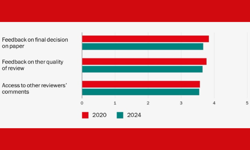
A study by IOP Publishing (IOPP) has highlighted differences in how physical science research communities adopt open data sharing and the various barriers they encounter.
IOP Publishing says over 30,000 research articles were analysed for the study, with the findings released in its whitepaper “Bringing researchers on board: Navigating the barriers to sharing data publicly”.
According to the publisher, environmental scientists are the most open with their research data, yet legal constraints related to third-party ownership often limit their ability to follow the FAIR principles. Physicists are also willing to share data but have concerns about the accessibility and understanding of the formats used. Engineering and materials scientists face the most significant barriers to sharing FAIR data due to concerns over confidentiality and sensitivity.
IOP Publishing outlined the key takeaways as follows:
Overall, only one in ten physical science researchers share Findable, Accessible, Interoperable, and Reusable (FAIR) data alongside their published articles.
Environmental scientists:
- Over 80% share research data openly
- Just under 60% follow the FAIR principles
- Biggest barrier: legal constraints due to third-party ownership of data
Physicists:
- Over 70% share research data openly
- Only 18% adhere to FAIR principles
- Biggest barrier: data format considered inaccessible even if available
Engineering scientists:
- Only 55% share their data openly
- Under 8% follow the FAIR principles
- Biggest barrier: no (known) repository to submit data
Materials scientists:
- Over 70% share their data openly
- Just under 5% follow the FAIR principles
- Biggest barrier: confidential or sensitive data
Access to data enables replication of research and strengthens trust in the results, added IOPP. The FAIR principles were introduced in 2016 to standardise metadata, assign persistent identifiers, and provide clear usage licenses, ensuring that research data can be easily located, accessed, combined, and reused with proper attribution.
Since 2022, IOPP says it requires all authors to include a data availability statement in their articles, outlining whether and how the data supporting their research can be accessed. This policy was extended in 2023, requiring authors who are unable or unwilling to share their data publicly to explain why.
Other ways the society publisher says it supports open data practices include introducing innovative content types within its journals. For example, its new open access Machine Learning journal series includes dataset, benchmark, and challenge articles.
Daniel Keirs, head of journal strategy and performance at IOPP and lead analyst of the white paper, commented on the findings: “What we’re seeing is that the barriers to open data are numerous and diversified, even within the physical sciences. We need to re-think several key areas, such as the standardisation of data formats, proprietary data issues, data repositories and how we incentivise data sharing. It’s going to take a concerted effort across the scientific ecosystem.”
Keep up-to-date with publishing news: sign up here for InPubWeekly, our free weekly e-newsletter.











